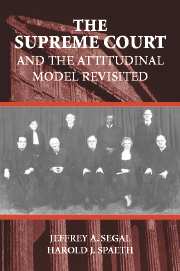Book contents
- Frontmatter
- Contents
- List of Illustrations
- List of Tables
- Preface
- 1 Introduction: Supreme Court Policy Making
- 2 Models of Decision Making: The Legal Model
- 3 Models of Decision Making: The Attitudinal and Rational Choice Models
- 4 A Political History of the Supreme Court
- 5 Staffing the Court
- 6 Getting into Court
- 7 The Decision on the Merits: The Legal Model
- 8 The Decision on the Merits: The Attitudinal and Rational Choice Models
- 9 Opinion Assignment and Opinion Coalitions
- 10 The Supreme Court and Constitutional Democracy
- 11 Conclusion
- Case Index
- General Index
11 - Conclusion
Published online by Cambridge University Press: 05 June 2012
- Frontmatter
- Contents
- List of Illustrations
- List of Tables
- Preface
- 1 Introduction: Supreme Court Policy Making
- 2 Models of Decision Making: The Legal Model
- 3 Models of Decision Making: The Attitudinal and Rational Choice Models
- 4 A Political History of the Supreme Court
- 5 Staffing the Court
- 6 Getting into Court
- 7 The Decision on the Merits: The Legal Model
- 8 The Decision on the Merits: The Attitudinal and Rational Choice Models
- 9 Opinion Assignment and Opinion Coalitions
- 10 The Supreme Court and Constitutional Democracy
- 11 Conclusion
- Case Index
- General Index
Summary
If the Supreme Court's decision that handed George W. Bush the election tells us anything, it's that the Supreme Court is more secure and more comfortable than it has ever been in pushing an agenda that is not only activist and conservative, but also blatantly partisan. Bush v. Gore illustrates the latter; while the disdain – and frequency – with which the Court demeaningly voids congressional legislation best evidences the former.
Despite the attack on state sovereignty in Bush v. Gore, an attack the conservative justices needed to produce Bush's victory, it is federal authority that the Rehnquist Court's guns have primarily assailed and which will continue to be subject to judicial assault.
As of this writing, the most recent manifestation of this assault came in Board of Trustees v. Garrett. Patricia Garrett, a nurse recovering from breast cancer surgery, found that her illness had cost her her job at an Alabama state hospital, in clear violation of the Americans with Disabilities Act. Though the Court recognized that the Eleventh Amendment (which applies to in-state suits only through judicial fiat) could be supplanted by the Fourteenth Amendment, and though Congress explicitly acted through its Fourteenth Amendment authority to enforce the equal protection of the laws, and though Congress produced voluminous records of state-sanctioned discrimination against the disabled, the Court's 5-4 decision found the state immune.
As usual, Linda Greenhouse got it exactly right:
More clearly than any precedent on which it built, the decision revealed the Supreme Court's real concern with the way power is allocated in the American political system to be less the balance between the federal government and the states than that between the Supreme Court and Congress.
- Type
- Chapter
- Information
- The Supreme Court and the Attitudinal Model Revisited , pp. 430 - 435Publisher: Cambridge University PressPrint publication year: 2002



